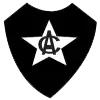 | |||
| Full name | Amapá Clube | ||
|---|---|---|---|
| Nickname(s) | Zebra da Presidente Vargas | ||
| Founded | 23 February 1944 | ||
| Dissolved | 2015[1] | ||
| Ground | Glicério Marques | ||
| Capacity | 5,630[2] | ||
|
| |||
Amapá Clube, commonly referred to as simply Amapá, was a Brazilian football club based in Macapá, Amapá. Founded in 1944, it last competed in the 2008 Campeonato Amapaense before folding in 2015 due to continuing financial constraints.
They were the second-most successful club in the amateur era of the Amapazão with 10 titles to their name. The most successful period in their history was in the late 1980s, when they won the league in three consecutive years, between 1986 and 1988. Following the professionalization of football in Amapá, however, their highest finishing position was of second place in 1991, 1993, 1998, 2005 and 2006.
The club was located in the centre of Macapá and traditionally wore black-and-white striped shirts, black shorts and white socks. The club crest was inspired by that of Botafogo de Futebol de Regatas, sporting a single white star inside of a black badge.[3] The club mascot is the zebra.[4] Amapá had a historic rivalry with Macapá, with whom they played the Clássico Vovô.[5][6][7]
History
Amapá Clube was founded on 23 February 1944 by Eloy Nunes Monteiro, Francisco Serrano, Pauxy Gentil Nunes, Newton Cardoso, Jose Serafim Coelho, João Vieira de Assis, Glicério de Souza Marques, Raimundo Nonato Araújo Filho, Raimundo de Campos Monteiro and Zoilo Pereira Córdoba. The meeting took place in the residence located in front of the first building of the Macapá City Hall – The state governor Janary Gentil Nunes attended the meeting, but did not sign the founding minutes. [4]
The club's first matches took place at the Praça da Matriz field, currently located in Praça Veiga Cabral. [note 1] In its first year of foundation, Amapá took part in the Campeonato Amapaense. The club won its first championship the following year, beating Macapá in the finals.[8]
In 1959, they won a friendly tournament played in Guyana, with two victories in three games played.[9]
Honours
State
- Campeonato Amapaense
- Champions (10): 1945, 1950, 1951, 1953, 1973, 1975, 1979, 1987, 1988, 1990
- Runners-up (5): 1991, 1993, 1998, 2005, 2006
- Torneio Início
- Champions: 2006[10]
References
- ↑ http://cnpj.info/Amapa-Clube
- ↑ "Cadastro Nacional de Estádios de Futebol" (PDF). CBF. 2016. Archived from the original (PDF) on 20 November 2022. Retrieved 6 October 2022.
- ↑ Pantoja, Railana (28 July 2020). "Deu zebra: sede do Amapá Clube vira lixeira e ponto de vandalismo". Diário do Amapá (in Brazilian Portuguese). Retrieved 9 October 2022.
- 1 2 Moreira, Rafael (23 February 2016). "Ao completar 72 anos, Amapá Clube zera dívidas e sonha voltar aos campos". globoesporte.com (in Brazilian Portuguese). Retrieved 9 October 2022.
- ↑ Cavalcante, Alcinéa (15 January 2015). "Sapiranga viu no Glycerão". Alcinéa Cavalcante (in Brazilian Portuguese). Retrieved 9 October 2022.
- ↑ Moreira, Rafael (14 January 2016). "Do passado ao presente, craques relembram histórias do Glicerão". globoesporte.com (in Brazilian Portuguese). Retrieved 9 October 2022.
- ↑ "AABB promove clássico 'Vovô' Macapá/Amapá para comemorar aniversário da cidade". Diário do Amapá (in Brazilian Portuguese). 2 February 2018. Retrieved 9 October 2022.
- ↑ Mello, Sérgio (23 November 2021). "Flâmula rara de 1973: Amapá Clube - Macapá (AP)". História do Futebol (in Brazilian Portuguese). Retrieved 9 October 2022.
- ↑ Lázaro, João (23 August 2014). "Foto Memória do Esporte Amapaense - Amapá Clube". PORTA-RETRATO - Macapá/Amapá. Retrieved 9 October 2022.
- ↑ "Amapá State League 2006 - Torneio Abertura". RSSSF. Retrieved 12 October 2022.
Footnote
- ↑ Called 'Praça Veiga Cabral' nowadays.
Further reading
- Garcia, Leonai (2009). Bola de seringa: A história do futebol amador amapaense de 1940 a 1990. Rio de Janeiro: Gryphus.
External links
- (in Brazilian Portuguese) Amapá Clube at Arquivo de Clubes